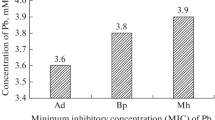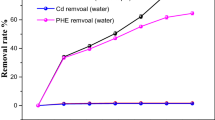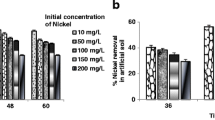Abstract
An unconventional nutrient medium, distillery spent wash (1:3) diluted) was used to produce di-rhamnolipid biosurfactant by Pseudomonas aeruginosa strain BS2. This research further assessed the potential of the biosurfactant as a washing agent for metal removal from multimetal contaminated soil (Cr-940 ppm; Pb-900 ppm; Cd-430 ppm; Ni-880 ppm; Cu-480 ppm). Out of the treatments of contaminated soil with tap water and rhamnolipid biosurfactant, the latter was found to be potent in mobilization of metal and decontamination of contaminated soil. Within 36 hours of leaching study, di-rhamnolipid as compared to tap water facilitated 13 folds higher removal of Cr from the heavy metal spiked soil whereas removal of Pb and Cu was 9–10 and 14 folds higher respectively. Leaching of Cd and Ni was 25 folds higher from the spiked soil. This shows that leaching behavior of biosurfactant was different for different metals. The use of wastewater for production of biosurfactant and its efficient use in metal removal make it a strong applicant for bioremediation.
Similar content being viewed by others
References
Kim J, Vipulanandan C (2006) Removal of lead from contaminated water and clay soil using a biosurfactant. J Environ Engg 132:777–786
Neilson JW, Artiola JF and Maier RM (2003) Characterization of Lead Removal from Contaminated Soils by Nontoxic Soil-Washing. Agents J Environ Qual 32899–32908
Desai J, Banat I (1997) Microbial production of surfactants and their commercial potential. Microbiol Mol Rev 61:47–64
Makkar R, Cameotra S (2002) An update on the unconventional substrates for the biosurfactant production and their (new) applications. Appl Microbiol Biotechnol 58:428–434
Dubey K and Juwarkar A (2001) Distillery and curd whey as viable alternative sources for biosurfactant production. World J Microbiol Biotech 17:61–69
Cooper DG, MacDonald CR, Dull SJB and Kosaric N (1981) Enhanced production of surfactin from B. subtilis by continuous product removal and metal cation additions. Appl Environ Microbiol 42:408–412
Dubey KV, Juwarkar AA and Singh SK (2005) Adsorption-Desorption Process Using Wood-Based Activated Carbon for Recovery of Biosurfactant from Fermented Distillery Wastewater. Biotechnol Prog 21(3):860–867
Robert M, Mercadé ME, Bosch MP, Parra JL, Espuny M J, Manresa MA and Guinea J (1989) Effect of the carbon source on biosurfactant production by Pseudomonas aeruginosa 44T1 Biotechnol Letters 11:871–874
Thaniyavarn J, Chongchin A, Wanitsuksombut N, Thaniyavarn S, Pinphanichakarn P, Leepipatipiboon N, Morikawa M and Kanaya S (2006) Biosurfactant production by Pseudomonas aeruginosa A41 using palm oil as carbon source. J General Appl Microbiol 52:215–222
Benjamin MM and Leckie JO (1981a) Multiple-site adsorption of Cd, Cu, Zn and Pb on amorphous iron oxyhydroxide J Colloid Interface Sci 79:209–221
Frazer L (2000) Innovations: lipid lather removes metals Environ Health Persp 108:320–323
Ochoa-Loza FJ, Artiola JF, Maier RM (2001) Stability constants for the complexation of various metals with a rhamnolipid biosurfactant. J Environ Qual 30:479–485
Wang S and Mulligan CN (2004) Rhamnolipid foam enhanced remediation of cadmium and nickel contaminated soil. Water Air Soil Pollut 157:315–330
Author information
Authors and Affiliations
Corresponding author
Rights and permissions
About this article
Cite this article
Juwarkar, A.A., Dubey, K.V., Nair, A. et al. Bioremediation of multi-metal contaminated soil using biosurfactant — a novel approach. Indian J Microbiol 48, 142–146 (2008). https://doi.org/10.1007/s12088-008-0014-5
Received:
Revised:
Accepted:
Published:
Issue Date:
DOI: https://doi.org/10.1007/s12088-008-0014-5




